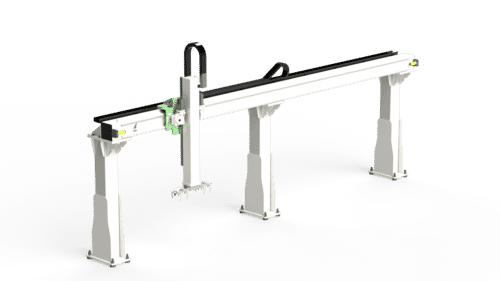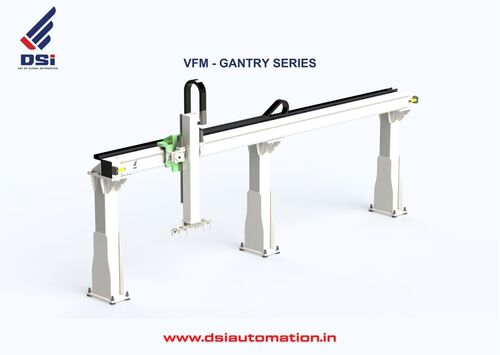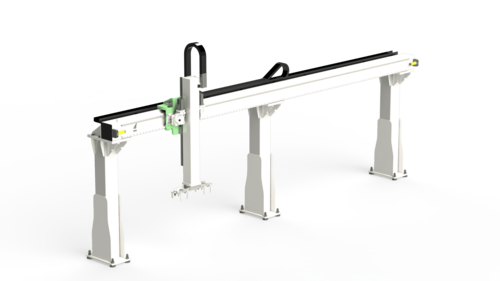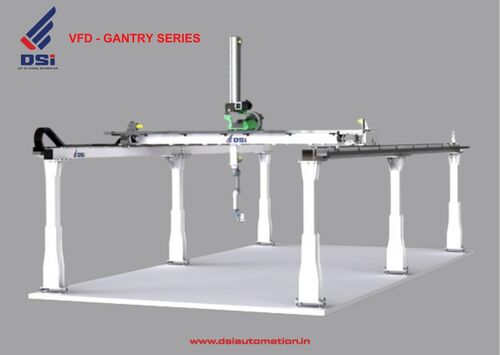3 axis Gantry Robot For Palletizing
Product Details:
- Usage Industrial
- Color White
- Size Different Sizes Available
- Condition New
- Attributes Strong Durable Easy To Operate Rust Proof
- Click to View more
3 axis Gantry Robot For Palletizing Price And Quantity
- 1 Unit
- 900000 INR/Unit
3 axis Gantry Robot For Palletizing Product Specifications
- Different Sizes Available
- White
- New
- Strong Durable Easy To Operate Rust Proof
- Industrial
3 axis Gantry Robot For Palletizing Trade Information
- Cash in Advance (CID)
- 60 Days
- Asia Australia Central America North America South America Eastern Europe Western Europe Middle East Africa
- All India
Product Description
A gantry robot designed for palletizing applications is a specialized robotic system tailored to efficiently handle the stacking of goods onto pallets in industrial settings. Here's a detailed description of the key components and features typically found in such a system:
-
Gantry Structure: The gantry robot features a sturdy framework consisting of horizontal beams (gantry) supported by vertical columns. This structure provides stability and rigidity to the robot, enabling precise movement along the X and Y axes.
-
End-Effector: The end-effector, also known as the gripper or tooling, is the component responsible for picking up, manipulating, and placing items onto pallets. In palletizing applications, the end-effector may be equipped with various gripping mechanisms such as vacuum suction cups, mechanical grippers, or specialized tools tailored to the specific products being handled.
-
Motion System: The gantry robot utilizes a sophisticated motion control system to precisely control the movement of the gantry and the end-effector. This system typically includes high-precision servo motors, encoders, and feedback mechanisms to ensure accurate positioning and smooth operation.
-
Programming Interface: The robot is programmable using intuitive interfaces such as teach pendants, graphical user interfaces (GUIs), or programming languages specifically designed for robotic applications (e.g., Robot Operating System - ROS). This programming allows operators to define palletizing patterns, specify product handling parameters, and optimize robot trajectories for maximum efficiency.
-
Vision System: Many gantry robots for palletizing applications are equipped with vision systems consisting of cameras, sensors, and image processing algorithms. These systems enable the robot to detect, locate, and orient products with precision, even in variable or unstructured environments. Vision guidance enhances the robot's flexibility and adaptability to different product types and palletizing scenarios.
-
Safety Features: Safety is paramount in industrial robotics, especially in environments where human operators work in close proximity to automated systems. Gantry robots for palletizing applications incorporate various safety features such as emergency stop buttons, safety scanners, light curtains, and protective barriers to minimize the risk of accidents and ensure compliance with safety standards.
-
Integration with Conveyor Systems: To streamline the palletizing process, gantry robots are often integrated with conveyor systems. Conveyor belts or rollers transport products to the robot's workspace, where they are picked up and placed onto pallets according to predefined patterns. Integration with conveyors enables continuous material flow and optimizes overall production throughput.
-
Scalability and Flexibility: Gantry robots designed for palletizing applications are inherently scalable and flexible, allowing them to adapt to changing production requirements. They can accommodate varying product sizes, shapes, and packaging configurations, making them suitable for a wide range of industries, including food and beverage, logistics, manufacturing, and e-commerce fulfillment.
Other Products in 'Gantry Robot System' category
GST : 33AARFD1027H1ZO
|
 |
DSI Industrial Automation and Machineries
All Rights Reserved.(Terms of Use) Developed and Managed by Infocom Network Private Limited. |









